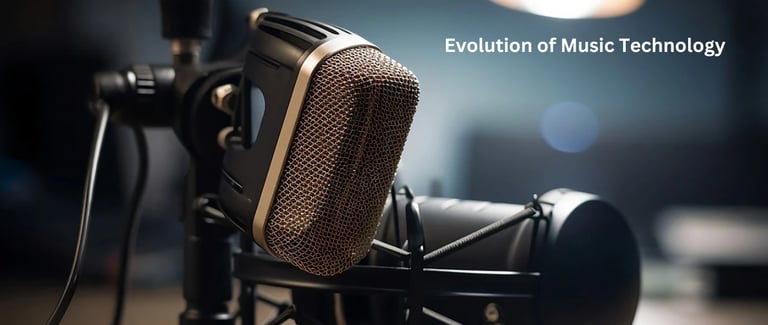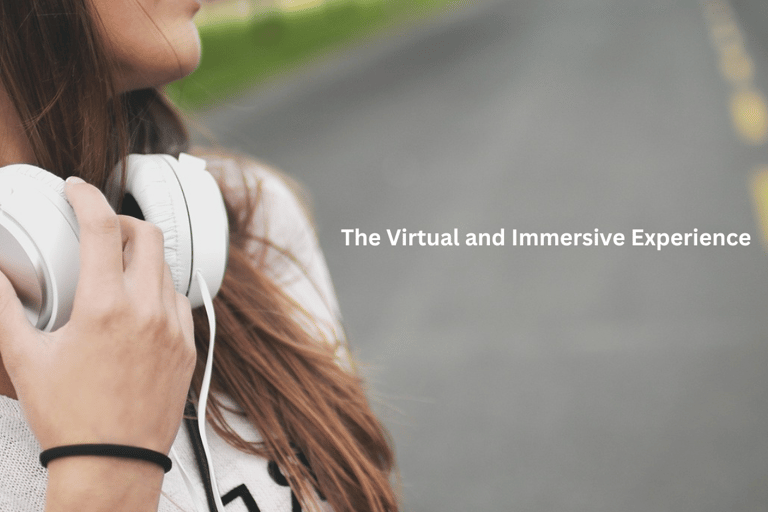The Evolution of Music Technology A Historical Perspective
1/15/20256 min read


History of Evolution of Music Technology Introduction
Since its very first creation, music and technology have gone very well together. The first manufactured instruments changed how people composed, communicated, and enjoyed music. So it is only through the history of music technology as if it were on a report card of inventions due to human genius and creativity. This paper will outline great moments in music technology history. It will also explain how it has shaped the music world and people.
History of Music Technology
The Earliest Gadgets
It is said that the first known human is the origin of the oldest technology in music. Of course, there were the naturally occurring drums, flutes, and lyres. Those are the oldest examples of humankind because he makes sound in a structured manner. For instance:
•Drums: Made from animal hide for rituals and communications
•Flutes: one of the oldest extant musical instruments, made from bone
Such discoveries would result in the creation of notated music that would most likely yield what cultures would tell of their tales.
Invention of notation to music
Sincerely, the invention of that which would later be identified as revolutionizing the world had long been invented into the genre of music. Indeed, the musicalization of how to notate while putting practice into work has been in constant reinvention since middle age. A work of beauty in paper, an art set onto paper, the same could go to the world's great crowd with the means of musical composition. Music writing innovation-made by Guido d'Arezzo in staff notation during the 11th century-the standards of compositions but now different musicians in one and same version of them.
The Mechanical Age
The Discovery of the Printing Press
In fact, in the 15th century, Johannes Gutenberg's printing press made sure that, by all means, it changed music's face. It became possible to have a few copies of one sheet of paper identical for the first time. Suddenly, music found itself within the scope of many more people than it used to be. Because of technological advancements, musical education has been democratized, bringing the chance to spread all the styles worldwide.
Music Boxes and Mechanical Instruments
By the 18th and 19th century, mechanically driven instruments entered the fray. These included, among others:
• Music boxes: These devices had cylinders with pins that would pluck the tuned teeth of a steel comb.
• Player pianos: Self-playing pianos were driven by perforated paper rolls.
These inventions brought the recording of sound onto the stage and astonished the audience with the fidelity and richness of sound.
The Electronic Revolution
Invention of Phonograph
Sound could, for the first time, be caught and played once again. Such an apparatus had created:
It was kept alive through performance.
Enabled them to open the door large enough for many listeners.
It also facilitated the emergence of an entire industry in music recording.
Radio and Emergence of Broadcast Sound
A radio was basically an appliance from which a listener could quickly access popular radio music and news. In much the same way as KDKA out of Pittsburgh, the invention of radio during the 1920s provided a new medium for the performer to become dramatic.
How Electronic Instruments Come About
To the composers and the performers, this exposed them to a whole new way they could produce a new form of music.
The Magnetic Tape Era
Magnetic Tape and Multitrack Recording
In the 1940s, this marked the advent of recording music through magnetic tape. With this came facilities of the following:
• Very high-quality recordings of sound
• Dubbing: artists would record tracks that they could later place on another track
• Editing: It improved the production quality
Les Paul invented the multitrack recording, which later developed into the type of studio recording applicable today.
From Humans to Cassette Revolution
Compact Cassettes. The technology was found in the 1960's. For the first time in human history, music had become portable. People could
• Create secret mixtapes
• Take on music
• Distribute records without complications
The Digital Age
The CD Optical Disc
The most crucial technological step of music in the 1980s was CDs. CDs provided:
Better quality than analog media
Long-lasting and portable
It is easier because it is accessed to play tracks or tracks repeatedly. More attention was given to this new technology than to vinyl records and cassettes.
Digital Audio Emerges
Digital audio file formats emerged in the early 1990s that included MP3s. That meant
• It compressed the file of music to share over the internet.
• The site will stream and download.
• New artists find independent recognition, and their products can easily travel to foreign soils without haggling through large studios.
Internet and Music Streaming
Now, this was a problem; however, this was an important step:
•Puts pressure on the industry to develop new business models
Development of Streaming Services
New services in the 2010s include streaming. Among them are Spotify, Apple Music, and many more. The services,
• Provide a listener with libraries of nearly endless music
• Rely on algorithms for an optimal experience for a user
• Pay artists not on the sales of the album but on streams.
How Music Technology Changed Live Performance
Sound Amplification and PA Systems
The electric amplification was discovered in the mid-20th century. Therefore, it opened up the possibility of:
• Performing to much larger audiences
• Much drama, much louder soundscapes
With current, thus today's PA systems, perfect sound in a concert is very possible.
Digital Effects and Loops
None of these, loopers and digital FX processors, are left out in today's music performance. The musicians already could do all that in real-time today:
Effect layering
Texture and atmosphere discovery
The evolution of this kind of sorting ended up with that nowadays; in an interview explaining this one, Radiohead was quoted as describing this live performance.
State of Modern Music Technology
DAWs (Digital Audio Workstations)
The music production software, particularly Ableton Live, Logic Pro, and Pro Tools, turned everything upside about music production. DAWs enabled the producers to do the following:
Record and mix right from computers;
Have virtual instruments and sound ensembles;
Work with other remote artists.
AI and Machine Learning in Music
It has transformed the art of composition and producing music. It is nowadays used in:
Films and video games also adopted AI when they produced their in-house soundtracks.
LANDR set the trend of paving the way to automation so that everyone could use it
It uses simple algorithmic searching to find which of these listeners would best serve them as it moves those playlists forward.
The Virtual and Immersive Experience
As much as can be opened through VR and AR. The concert experiences will come forth from the artists living today around them and the fans who dive into an already existing virtual world set up through some inspiration born from that one artist's song.
Problems and Ethical Dilemmas
Copyright Ownership
Most of these are here in electronic land because of copyright infringement. A few remain in view, such as download and sample; they are on the not-so-shrinking list.
Technology vs Authenticity
Too many options do have some resemblance to authenticity. Music auto-tunes and AI usage is human enough, so the humanness is taken from the music.
Music Future Tech
Blockchain for Music
Blockchain is the future pragmatic way of changing the world where music creators get paid. Its royalty mechanism is fairer and more transparent, and one can then claim them at Audius.
Green Music Production
The company is searching for ways to produce music 'green' Vinyl is an example. The carbon footprint would be similar to that of a streaming server.
The future sound: Participants will surge in interaction as they go through the actual event and also when they can be interactive themselves. They may end up using virtual reality and even applications when it comes to AI.
Well, it proves that this is rather creative imagination thought up by human minds: a gamut developed from being just the simplest of those music-making instruments and so forth through progress into much more sophisticated pieces that could even utilize AI. Every innovation can imprint deep marks on music's creation, distribution, and consumption. Nothing is found to connect, nothing to do and think for a musician or even for the audience, with superior technology seen in the present scenario.
FAQs
1. Why is music technology important?
Music technology transforms the art of composition, distribution, and listening since it provokes creativity and openness.
2. How did the phonograph affect music?
Recording, then playback through phonograph technology, ignited the birth of the recording industry.
3. What is digital audio?
This invention changed the very way people make their music disseminate. Then streams and downloads were born. World music can now be accessible.
4. How will AI influence musicians?
AI helps make everything that much easier and more convenient. For example, in mastering and also in composition,
Music technology in the future
Blockchain for royalties, being green, becoming fully immersed inside the VR.







